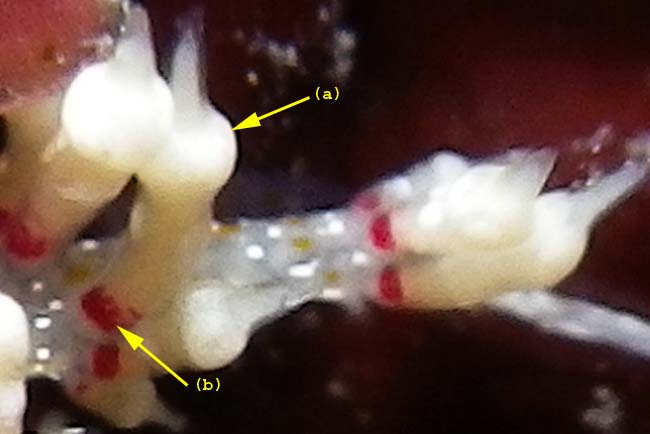This species has been observed on Reunion Island
Species characteristics : Body translucent with numerous opaque white and orange spots The lower third of each cerata is transparent and the upper two third are opaque white or creamish. A prominent purple-red spot is present at the base of each cerata where it joins to the body Rhinophores with 2 large annulae towards their upper half |

|
|
| Showing species characteristics... | Photo Sullly Bachel |
|
Remarks :
Synonymous (according worms) :
- Hervia affinis Baba, 1949
Bibliographic data :
Very similar in general shape to Cratena affinis but has some significant consistent differences in external shape and colour. In particular it lacks white lines on the cerata and lacks a red patches on each side of the head.
This is a small nudibranch with a long and slender body. The tail is very long and the tip is pointed
The oral tentacle are multicolored the basal area is translucent with a few opaque white spots then there is a brown ring, and the upperhalf is uniformly opaque white
The cerata are slender but swollen towards the distal third. They are arranged in five discrete cluster in symmetrical pairs
The lower half of the rhinophore is translucent with a few large opaque white spot and the annulated upper half is uniformly white
References :
Bill Rudman Seaslug site : Sea Slug Forum : Cratena cf. affinis
Medslug Cratena cf. affinis
Publications :
Baba, K (1949) Opisthobranchia of Sagami Bay collected by His Majesty The Emperor of Japan . Iwanami Shoyen, Tokyo. 194pp., 50 Pls pages.
Other photos of Cratena cf. affinis :
 |
Philibert Bidgrain Reunion, Etang salé on the rocky coast, less 1 m, 24 February 2011, size : 13 mm The cerata are slender but swollen (a) towards the distal third. A prominent purple-red spot (b) is present at the base of each cerata where it joins to the body .jpg)
|
Sully Bachel Reunion, 25 November 2012
The oral tentacle are multicolored the basal area (a) is translucent with a few opaque white spots then there is a brown ring (b), and the upperhalf is uniformly opaque white (c) |
|
 |
Christophe Cadet Reunion, Etang salé lagoon, less 1 m, 17 November 2011, size : 4-5 mm
A small specimen...
|
More photos from Indian Ocean
If you have taken a photo of this species in South West Indian Ocean, please Contact us...
.jpg) .
.